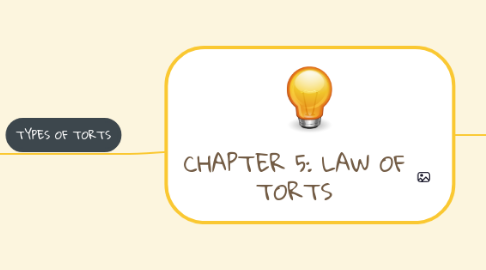
1. TYPES OF TORTS
1.1. NEGLIGENCE
1.1.1. is lack of proper care and attention.
1.1.2. 3 elements that must be established by the plaintiff to be successful
1.1.2.1. duty of care owed by the defendant to the plaintiff
1.1.2.1.1. neighbour principle by Lord Atkins
1.1.2.2. breach of duty of care by the defendant
1.1.2.2.1. reasonable man test
1.1.2.3. breach caused the claimant reasonably foreseeable damage
1.1.2.3.1. But-for-test
1.1.3. defences
1.1.3.1. contributory negligence
1.1.3.2. volunti non-fit injuria
1.1.3.2.1. applicable case: master and servant relationship, games and sports, rescue, passengers.
1.1.3.3. exclusion clause
1.1.3.4. inevitable accident
1.1.3.5. act of good
1.1.3.6. necessity
1.2. DEFAMATION
1.2.1. is the publication of a statement which tends to lower a person in the estimation of right thinking member of the society generally
1.2.2. types
1.2.2.1. libel
1.2.2.1.1. is a written or printed defamation.
1.2.2.1.2. occurs when a person's character defamed in written form includes permanent visual and audio recording, publication
1.2.2.2. slander
1.2.2.2.1. means spoken defamation.
1.2.2.2.2. occurs when a person's character has been defamed verbally
1.2.3. 3 elements need to prove
1.2.3.1. the statement must be defamatory
1.2.3.2. the said statement must refer to the plaintiff
1.2.3.3. the statements have been published
1.2.4. defences
1.2.4.1. consent / volunti non fit injuria
1.2.4.2. justification
1.2.4.3. fair comment
1.2.4.4. absolute privilege
1.2.4.5. statutory privilege
1.3. TRESPASS TO PERSON
1.3.1. involve the wrongful invasion of a person's right to freedom from interference with his body or his right to personal liberty
1.3.1.1. means that claimant only needs to show the trespass occurred and it is not necessary to show defendant caused any damage.
1.3.2. types
1.3.2.1. assault
1.3.2.1.1. means any direct threat by a person that places another person in reasonable fear of imminent contact
1.3.2.1.2. 4 element need to be prove by claimant
1.3.2.2. battery (serang sentuh)
1.3.2.2.1. means any direct act by a person which has the effect of causing contact with another person without their consent.
1.3.2.2.2. 4 elements must be prove by the claimant
1.3.2.3. false imprisonment
1.3.2.3.1. is the unlawful imposition of constraint on another's freedom of movement from a particular place
1.3.2.3.2. 3 element to prove
1.3.3. DEFENCES
1.3.3.1. self defence
1.3.3.2. voluntary consent
1.3.3.3. sport
1.3.3.4. lawful arrest
1.4. NUISANCE (kacau ganggu)
1.4.1. is an unlawful interference with a person's use or enjoyment of land or some right over or in connection with it.
1.4.1.1. threatens the health, safety, moral, comfort, and welfare of community
1.4.2. public nuisance
1.4.2.1. affect of individual of a large number of people
1.4.3. private nuisance
1.4.3.1. affects an individual or the property rights of a small number of people
1.4.3.2. 2 elements must be proven
1.4.3.2.1. interference must be substantial
1.4.3.2.2. interference must be unreasonable
1.4.4. defences
1.4.4.1. consent
1.4.4.2. contributory negligence
1.4.4.3. act of God
1.4.4.4. inevitable accident
1.4.4.5. statutory authority
